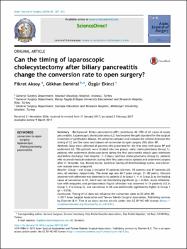Can the timing of laparoscopic cholecystectomy after biliary pancreatitis change the conversion rate to open surgery?
Citation
Aksoy, F., Demiral, G., & Ekinci, Ö. (2018). Can the timing of laparoscopic cholecystectomy after biliary pancreatitis change the conversion rate to open surgery?. Asian journal of surgery, 41(4), 307–312. https://doi.org/10.1016/j.asjsur.2017.02.001Abstract
Background: Biliary pancreatitis (BP) constitutes 30-55% of all cases of acute pancreatitis. Laparoscopic cholecystectomy (LC) has become the gold standard for the surgical treatment of gallbladder disease. We aimed to compare and evaluate the relation between the timing of LC and the rates and reasons of conversion to open surgery (OS) after BP. Methods: Data were collected of patients who presented for the first time with acute BP and underwent LC. the patients were divided into two groups: early cholecystectomy (Group 1), patients who underwent cholecystectomy during the first pancreatitis attack upon admission and before discharge from hospital (1-3 days); and late cholecystectomy (Group 2), patients who received medical treatment during their first pancreatitis episode and underwent surgery after 4-10 weeks. Sex, Ranson scores, American Society of Anesthesiology scores, and conversion reasons were compared. Results: Group 1 and Group 2 included 75 patients (20 men, 55 women) and 87 patients (25 men, 62 women), respectively. the mean age was 44.7 years (range, 21-82 years). Obscure anatomy with adhesions was detected in 16 patients (5 in Group 1, 11 in Group 2) as the leading cause of conversion to OS, but it was not statistically significant (p=0.054). Acute inflammation with empyema and peripancreatic liquid collection was observed in 14 patients (12 in Group 1, 2 in Group 2), and conversion to OS was statistically significantly higher in Group 1 (p=0.016). Conclusion: Timing of LC does not influence the conversion rates to OS after BP. (C) 2017 Asian Surgical Association and Taiwan Robotic Surgical Association. Publishing services by Elsevier B.V.


















